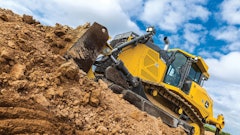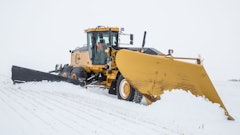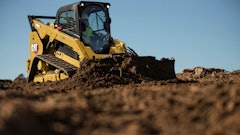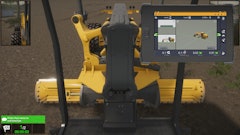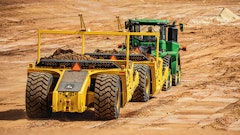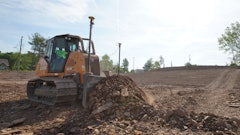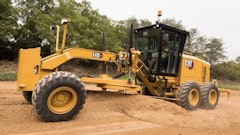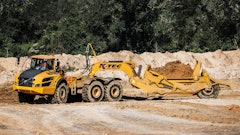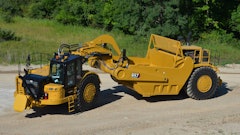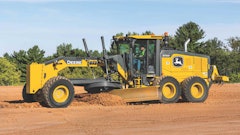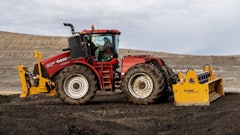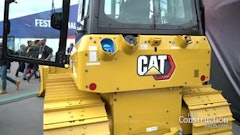
Whether motor graders are used as a first step in the rough grading process, for fine grading to prepare dirt for placement of stone, or to grade stone prior to construction of an asphalt base, the equipment must be maintained so it's responsive to the commands of the operator.
On most motor graders a moldboard or blade is attached to a turntable, which is connected to the frame. Hydraulic cylinders lift the turntable (and the blade) up and down while a third cylinder enables the turntable and blade to move from side to side. A system of gears enables the operator to rotate the blade up to 360 degrees if needed.
"The whole machine is there just to push that blade," says Keith Lee, research and development for LeeBoy, which manufacturers four graders in different size categories and recently introduced the 705, a 17,000-lb. machine. "All it's doing is pushing that blade so you need to do everything you can to make it as easy as possible for the machine to do that. When the operator is doing precise work the motor grader needs to be able to respond properly, so certain areas need to be monitored."
Moldboard maintenance
The moldboard is where all the action takes place, and that's why special attention needs to be paid to it. This is the part of the machine that engages the soil, cutting it to the proper shape and fine-tuning soil or stone before paving.
"The most important maintenance part of a motor grader is maintaining a good cutting edge on the equipment," says Shannon Chastain, president of Basic Equipment, manufacturer of the Basic Model 601 articulating grader. "All too often the biggest neglect is the cutting edges."
Bolted in place to the moldboard, there is a cutting edge along the bottom of the blade, and some graders also have cutting edges bolted to each side of the blade. Because these edges cut into the dirt and are constantly engaged with the material, they wear out depending on hours of use, abrasiveness of material, and even operator skill.
"Cutting edges and end bits are wear points that need to be monitored and replaced pretty often, occasionally in a single day if you've done a lot of work in an abrasive environment," Lee says.
"Wear also depends on what pitch the operator runs the blade at," Chastain says. "If you're running the blade at a right angle it will wear more slowly, but when the blade is pitched back it will wear on the moldboard more quickly."
Miller Griffith, sales and marketing manager for The Factory Co., manufacturer of the H-Mach Cross Blade utility grader, says a certain depth of the cutting edge needs to be exposed for the grader to work effectively. He says 1½ in. of useable space on the cutting edge will perform fine. "But if you burn through 1 inch of that and you don't replace it you're going to continue to wear it down and eventually wear into the moldboard," Griffith says.
Manufacturers agree that a worst-case scenario involves neglecting the cutting edge of the blade to the point where the work is wearing into the moldboard. "When that happens you lose the integrity of the moldboard to maintain the cutting edge," Chastain says. "You get to the point where you can't replace the cutting edge, so you've got to replace the moldboard."
Some graders, such as the Basic Model 601, use a reversible cutting edge so that when it's worn on one side contractors can unbolt it and flip it around. Cutting edges are held in place by up to a dozen bolts, which cost $3 to $4 each, and should also be replaced because they also operate in the dirt and become worn. Replacement of cutting edges and bolts will cost roughly $100 and take 30 minutes using an air-impact wrench. Manufacturers recommend visually inspecting the cutting edges every 25 to 50 hours depending on the type of material the machine is working in.
Blade slide & turntable
An important component of the moldboard is the blade slide, sometimes called the moldboard slide, which enables the moldboard to move from side to side on a swivel track. The slide relies on guides to control the movement of the slide and the guides will wear down through use.
"Most guides wear down, some quicker than others," Lee says. "Some are brass and some are just metal shims." He says LeeBoy's 25,000-lb. Model 785 motor grader uses bronze guides, and those must be replaced when they wear out. LeeBoy's 15,000-lb. Model 685B relies on metal shims instead.
"On the 785 there are two caps with six bolts that you need to remove. Then you just push the guides out by hand and replace them," Lee says. "The guides are located on four different points - the upper and lower edges on each end of the slide - and all should be replaced at the same time. It's an easy and quick process."
As use causes the bronze guides wear, metal shims can be used to make the bronze guides last as long as possible before replacing them. With or without bronze guides, shims are a valuable tool for keeping the blade tight. "If, for example, there's 1/8 inch of play in the guide you can slide 1/8-inch shims in place to take the play out," Lee says.
Griffith says the Cross Blade relies on bushings in the slide, but they need to be monitored, too. "If they're worn and they have a lot of play in them, that reduces the operator's ability to get the fine grade cuts he wants," Griffith says. "You want to get the grading down to a gnat's hair, and if there's too much play in those bushings you need to replace them."
Chastain says the easiest way to check the wear in the slide is to lift the blade off the ground, grab its end, and move it up, down, left, and right to check for looseness in the movement.
"If you do see play in the blade you need to remove clevis pins and inspect them to see if they need to be replaced," he says. "The pins that first show wear are on the blade angle because when you're cutting along a concrete slab, for example, the blade edge engages the concrete, putting a lot of impact on the cylinders and causing the pins to wear." Operators can replace these themselves at a cost of around $5 or $6 per pin.
Lee recommends checking the slides and guides "every month or so," though it depends on how many hours the grader is working and the type of material it engages.
"It also depends on how precisely they're going to be working," Lee says. "If they're not working too precisely they can withstand a little more play in the slide. If they're running a job with lasers on it then they need to be more precise and they have to make sure there's no play in the slide."
Air filters need to breathe
Whether it's dirt from rough or fine grading or dust from grading stone prior to paving, motor graders operate in probably the dirtiest environment of any piece of equipment, so it's important to keep the machine's air filter clean.
"Dirt can really damage the equipment, so air filtration on this type of equipment is a big deal," Lee says. "A lot of people just don't give it the emphasis and attention it needs."
Griffith says that in addition to potential equipment damage, a clogged air filter reduces the motor grader's efficiency. "When that happens you end up using more fuel, and with fuel being as expensive as it is you want to make sure to run as efficiently as you can," Griffith says.
Chastain adds that the structure of a motor grader makes it more likely its filter will get dirty. "On motor graders most engines sit fairly close to the ground relative to where the engine would be on a track loader or excavator, for example. So motor grader engines get a lot of drafting beneath the machine and can pull a lot of particulates out of the air," he says.
He adds that because smaller graders are typically used in confined areas such as parking lots at convenience stores, they are more susceptible to dirt. "In confined areas there is often less air movement, so when particulates from the dirt or stone disperse into the air they just stay there, floating in the air rather than being blown out of the way like they would in an open space," he says. "That makes it more likely particulates would get into the air filter."
So check air filters according to manufacturers' recommendations (often every 250 hours) but check them more frequently if the weather has been dry or you are working in confined areas.
Lee adds that many motor graders (and other dirt machines as well) feature a "restricted alert" on their filters indicating when air flow has been restricted due to a dirty filter. "So you need to keep an eye on that," Lee says.
He says that because a clean filter is so important LeeBoy graders feature turbo pre-cleaners as standard items. "Pre-cleaners and two-stage filters knock out a big percentage of dirt before it gets to the air filter. So if you don't have one on your machine you should consider adding it." Using a pre-filter also means you have to change the regular air filter less often.
"Pre-filters are definitely a good thing," Chastain says. "Pre-cleaners remove a lot of floating particles before they make it into the air filter, and if you think they don't work just put one on there and watch for yourself."
Make sure teeth have bite
Used to break up the soil to ease the moldboard's work, scarifiers are standard on some machines and available as an option on others. They can be used any time there is rough grading or when cut-outs are required, and their use will allow the grader to cut more precisely if the material has been loosened first.
"They definitely speed things along and result in a lot less stress on the machine itself if you use them to loosen material before blading," Chastain says.
Often referred to as "rippers" by some contractors, scarifiers have teeth that need to be checked regularly and replaced before they get too worn. The teeth, which are attached to a shank on the scarifier, have a pocket at one end and a cutting surface cast or welded to that pocket. "At the point where the wear strip is gone and you begin to wear into the pocket it's time to replace them," Chastain says. "All too often we see situations where teeth are worn into the shank of the scarifier, and the next time the contractors goes to replace the teeth there's nothing to engage."
He says replacing the shank costs roughly $45 per shank for the lower power class of grader, which becomes a costly repair for what could have been simply replacement of the teeth.
Operator station & controls
An often overlooked aspect of motor grader maintenance is the operator station and the controls themselves. Griffith says operator safety is critical, so seatbelts should be checked - and used - daily. "Check the matting on the deck, too, so that when the operator is standing he's standing on firm ground," Griffith says.
To assure consistent grader performance the controls in the cab must be responsive to the operator and must be able to provide what the operator is looking to get out of them. "The handles that control the blade develop a lot of play in them, and the handles need to be snug so that when the operator moves the handle it moves the blade just as he wants it," Lee says. "I've seen handles on working equipment with three times the play in them that they should have. Too much play in the handles makes it difficult for the operator to get precise work done on the site. You have to keep the handles tight so you have precise control over the machine."
Some motor graders, such as the Cross Blade, rely on cables to connect the controls to the blade. "As the cables get older they can get a little sloppy and might need a little adjustment," Griffith says. "You just need to tighten them up a little bit if they're not as responsive as you'd like them to be."
Unlike the Cross Blade, the LeeBoy machines' controls rely on replaceable bushings and ball joints in handles. "The handle pivot points have bronze ball joints, and those should be replaced when there's too much play in them," Lee says, adding that lubrication of the handles helps delay wear.
Keep tabs on tires
Manufacturers say that all too often motor grader operators neglect the tires, which are essential to the grader's effort. Proper tread and air pressure need to be monitored throughout the season. "Tire pressure has a big impact on traction, and a grader is only as good as your traction," Griffith says. "If the pressure is too low and the machine is going up and down all the time that affects the grade." He says some contractors are using nitrogen in their tires because it's an inert gas and temperature change doesn't affect tire pressure.
Tread is also an issue, more for cut-outs and rough grading than for fine grading. "To get the most efficient operation out of the machine you need to have the tires in good working condition. If the tires are worn you're wasting time out there," Chastain says. "By allowing the tires to spin you're not getting enough traction to allow the grader to perform properly."
The spinning tires are not only inefficient but can dig ruts in the grade and even allow the machine to slide if the operator is working on sloped terrain. "It's hard to maintain true direction or consistent depth if they're spinning, so instead of a clean, graded cut you'll have gouge marks in the dirt," he says.
Tires should be inspected regularly with every visual inspection of the grader. "If the tread is less than a half inch deep you're wasting your time," Chastain says. "If the tires are not in good condition you can't get sufficient bite on ground engagement to be successful."
Basic Motor Grader Maintenance: "Everyone Should Do It"
"A grader is like your car," says Miller Griffith, sales and marketing manager for The Factory Co. "If your car sat all winter what would you do to get it ready for the spring? That's the place to start in getting your grader ready."
Griffith says all engine components, including coolants, fluid levels, and hydraulic and air filters should be checked before the start of the season and then regularly throughout the season, and owners' manuals should be followed for timing. Engine oil should be sampled and tested every 250 hours to see if there are any metal shavings or fluids in there that shouldn't be there. Battery contacts should be clean and tight. And operators should always check the fan belt.
"You don't want to break down over something as simple and easy to check and replace as a fan belt," Griffith says.
The entire grader also should be cleaned and serviced, which means checking all seals and lubricating and greasing where the operator's manual suggests - the front attachments, quick attach, moldboard, and lift cylinders, for example. Keith Lee, research and development for LeeBoy, adds that contractors who don't want to regrease the equipment themselves can install systems that will automatically regrease the machine for them on specified intervals.
Shannon Chastain, president of Basic Equipment, recommends keeping a check on the hydraulic cylinder where it attaches to the machine. "It's very important to keep an eye on the clevis points and pins," he says. "The more slop you get in those pins from the work the more wear they develop. The more wear they develop the less accurate you will be in your grading because the blade will bounce around."
He says clevis points and pins on a new grader should be checked at 500 hours of use; after that, make the checks at 350 to 400 hours.
Griffith says operators should look for "any weeps or drips that they can't account for."
"All machines have weeps, and they're not a factor at first. Some leaks are acceptable as the seals age, but if you see more than a drop or two and the leaks get to different levels you need to take a look and figure out what's happening," Griffith says.
"All these need to be checked before your season starts and then monitored throughout the season. Everyone should do it," Griffith says.







